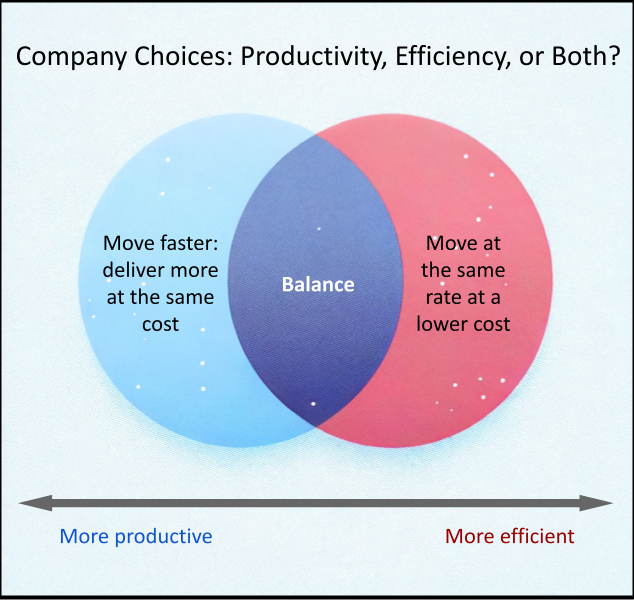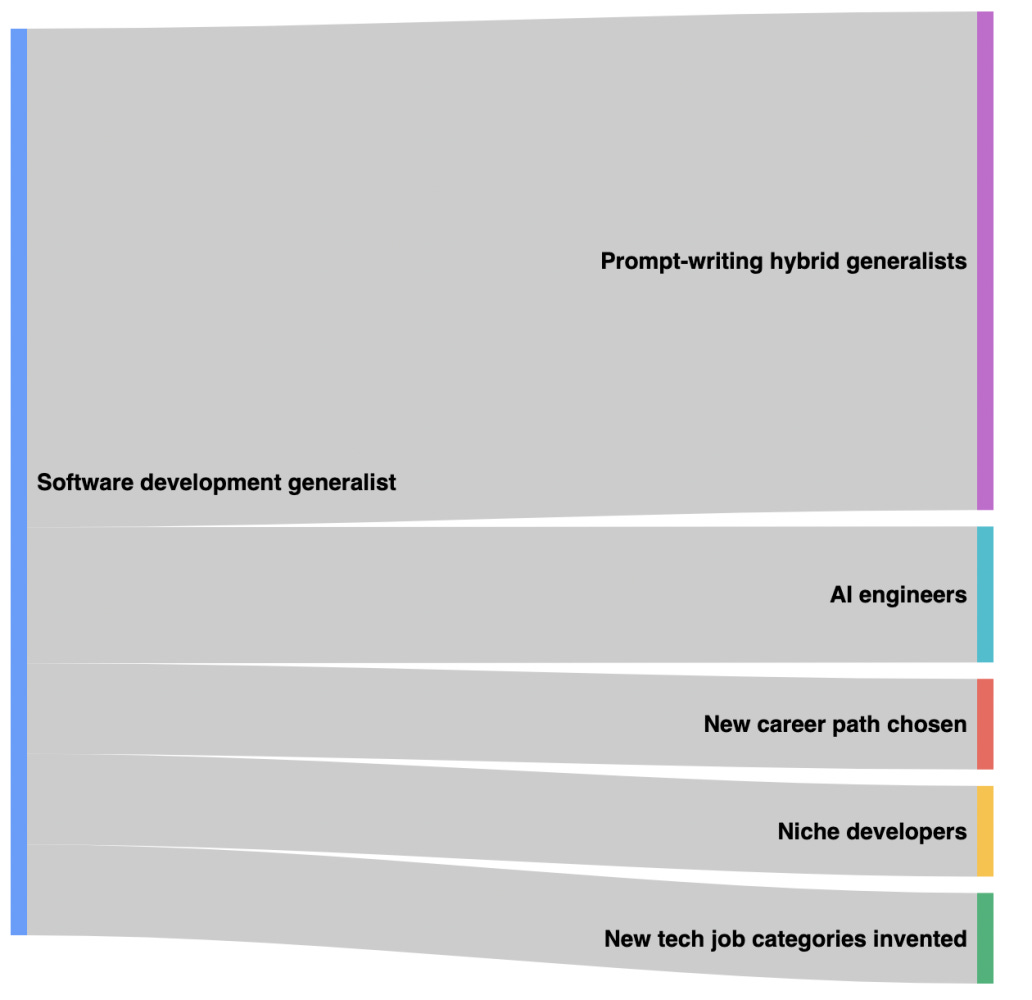How AI is Reshaping the Talent Landscape
The Rapidly Changing Role of the Software Development Generalist
The Main Idea: Learn to Ride the Wave
There is no avoiding the AI wave as it inundates the software development world. As software development companies work to get their arms around the potential of AI to improve their operations, serve their customers, and build value for their shareholders, there is substantial evidence that the equilibrium between talent and technology is shifting. Companies will be deciding whether to replace or augment human talent with AI. For some, the balance slowly and irreversibly will tip from one side to the other. For others, an explosion of human-led divergent creativity and innovation awaits. Developers will need to adapt quickly to ensure their long-term earning potential.
“Over the course of the last 10 years, 15 years, almost everybody would tell you it is vital that your children learn computer science. Everybody should learn how to program. In fact, it’s almost exactly the opposite. It is our job to create computing technology such that nobody has to program, and that the programming language is human… You can imagine everybody in your company being a technologist.” - NVIDIA Founder and CEO Jensen Huang
Key Points
Companies have a talent strategy choice to make as it relates to AI: Be more productive by delivering more, faster; be more efficient by delivering at a lower unit cost; or achieve a combination of both.
The bedrock talent role of our industry, the software development generalist, is undergoing transition due to AI LLMs. 2022 research concluded that even the antiquated GPT-3 model used by “human non-coders using GPT-3 were able to do the same task as the coders” in the same amount of time.*
There is an industry-wide “talent correction” as companies are reallocating hiring dollars to onboard AI “talent.” This is causing a slowdown in hiring and salaries to flatten out for software development generalists.
Despite the signals in the labor market, historically we have seen that a reduction of costs (inexpensive tools boosting productivity) don’t lead to lower wages nor have they led to less employment. IT products and services costs have dropped 93% since tracking began in 1988 while wages have increased 77% over the past 20 years.* The US Bureau of Labor Statistics predicts that job opportunities in our space will grow “much faster” (25%) in the next 10 years.*
After a period of volatility, AI will ultimately spur growth in software development jobs, fueled by a gold rush surge in investment followed by an explosion in innovation. As with other disruptive technologies attracting lots of attention, there will be a frothy speculative bubble that rides along in its wake. Gobs of new companies, tons of new jobs, and plenty of new products means there will be a historically proportionate number of winners and losers.
Predictions are Precarious
When it comes to massively disruptive technological innovations, “far-reaching consequences, which unfold over decades, are difficult to anticipate, particularly in relation to labor demand.”* And the time horizon of change is difficult to predict due to “a costly and time-consuming process involving the discovery of new business procedures.” Research varies greatly on the range of job impacts due to AI (a 9% - 47% range) so maintain perspective as you read this. The World Economic Forum changed its jobs outlook from 12 million jobs created to 14 million jobs lost between their reports in 2020 and 2023. Nobody knows the future, including people who write papers on jobs or AI. This content is supported with hard data plus some hypothetical imagining of how things may change, over time. Hammer away in the comments!
The Perspective from the Business
Companies have choices to make:
How to adopt AI: build it, buy it, or a bit of both?
Why to adopt AI: productivity, efficiency, or a balance?
When and where to adopt AI - based on costs, risks and expected value
The Balance Between Technology and Talent
A company’s technology and talent strategy must be considered together. Decisions as they relate to business needs are made by understanding the evolving potential of technology and human capital.* When a company decides to attack a business opportunity, it must assess whether to “build it or buy it.” As advances in AI continue, there will be increasing evidence and experience that convince companies they can operate more efficiently (deliver at the same rate for lower cost) by investing in AI talent in exchange for human talent. But they have other options as well.
Consider choices a company can make about how, when, and why to go to AI:
The Converts: Efficiency Seekers - Companies will buy AI talent off-the-shelf whose job is to do the work of software engineers. These companies are seeking higher return on invested capital (ROIC) by leveraging more efficient means of production.
The Hybrids: Balance Seekers - Companies will choose a mix of replacing people with AI and reskilling their current talent. Some teams will be largely replaced with AI, such as those that can benefit from automation. Other teams will be heavily AI-enabled, staffed with developers with great prompt-writing skills.
The Reskillers: Productivity Seekers - Companies will choose to retrain and retain their human workforce*, adopt AI vigorously, and reap benefits not in operational expense but in productivity. They seek higher volume output per dollar spent. 2023 research shows productivity benefits of 53% for Copilot-enabled developers over developers without AI assistance.*
The Laggards: Stability Seekers - Companies will embrace the status quo and justify this due to idiosyncrasies of their production process, their risk aversion, or their corporate culture. For these companies, these may be valid reasons. A laggard may ultimately convert when conditions are right for them. In the meantime their near-exclusive reliance on human talent may harm their standing in the eyes of shareholders related to the productivity of their capital. Slower adoption isn’t necessarily a bad idea, it simply means the company has needs that the current level of AI capability doesn’t satisfy. But late adopters should check back frequently, since “the compute required to reach a set [AI] performance threshold has halved approximately every 8 months,” far faster than predicted by Moore’s Law *
Transparency on AI Talent Strategy
Companies should have a plan and foster transparent communication with their employees regarding AI's role and its impact on job security, supporting a culture of trust, future-proof talent growth, and bold innovation. Once a company has made a decision around how they intend to strategically employ AI, this should be shared out in tandem with plans for supporting reskilling. This openness serves to both demystify AI technologies as well as help employees understand how their roles might evolve and what skills they will need to adapt.
Commitment to Reskilling
Harvard’s Digital Reskilling Lab and the BCG Henderson Institute released a study “Reskilling in the Age of AI,” which lays out imperatives for businesses to support talent development in preparation for broad adoption of AI, which I’ll paraphrase here:
Reskilling requires strategic planning and change control. With a tectonic shift this big and skills gaps this broad, only a strategic program of reskilling will meet the need. Consider adopting a skills taxonomy and mapping skills to each role to get to a plan.
Reskilling should be driven by every leader at the company. Hold managers accountable and provide them with external training support if needed.
Partner with employees. Companies should get employees involved to build awareness, buy-in, and provide them with information and time to make their own decisions about what they want to do with their careers in light of the profound changes coming.
The Demand Side of the Talent Market
On the demand side, look at how the need for AI skills is influencing job listing changes, how companies are pricing the value of their talent, and layoff data. There is strong proof that demand is up for AI jobs and down for most other roles in IT. The market price for talent is flat to lower for most IT jobs with AI jobs being a big exception.
Signals and Counter-signals
In January, the Wall Street Journal reported that in 2022, the IT sector grew by a net of 267K jobs. In 2023 it added only 700 jobs. The majority of job gains were in AI and semiconductor (supporting datacenter growth for AI) and that the smallest percentage of gains went to entry level tech hires. Companies are hiring more senior folks with strategic skills.
On March 5, the WSJ reported that IT job listings are down 31% from 18 months ago. In the same period, AI job listings are up 42%.
Two weeks later, on March 18, they reported on trends in layoffs and unemployment in IT. The data cited in the article said that IT unemployment rates are higher than the national average for all job types and the sector will likely continue to shrink in 2024, by 20-30K jobs.
A week later, they reported about the million dollar pay packages being offered to top AI talent. They showed a $100K pay gap in median salaries between AI and non AI jobs.
A November 2023 survey of 750 business leaders by ResumeBuilder found that 40% of companies were planning on replacing employees with AI by doing layoffs in 2024. (Not specific to software development roles)
The WEF subsequently predicted that over the coming years ⅔ of companies will see job growth from AI, while ⅓ will see jobs lost.
Interpretation of the Signals
There is a “talent balance correction” unfolding, where companies are scrambling to acquire AI talent and evaluate how new tools shift their production and process. Since hiring budgets are zero sum, these hires come at the expense of other roles. Once companies gain the skills they need through hiring and adapting their current talent, they will revert back to traditional hiring ratios (if they are productivity seekers). Following this, as companies and investors imagine how to capitalize on the generative potential of AI, a surge in job creation will follow. New job categories will emerge that are evolved descendants of the software development generalist role.
The Perspective from the Talent
For software developers, this is an issue of skills adoption and change resilience. The intellectual curiosity that is at the core of every great developer should propel them into this exciting new realm.
The Supply Side of the Talent Market
Basic economics prevails. Salaries are going up for AI talent because there aren’t enough people with the skills to do the work. To capitalize on this opportunity, some people will reskill towards opportunity. But the bar is higher for AI jobs*. Most skills shifting for software developers will be towards improved prompt writing within AI development environments like Devin and integrating with AI platform APIs. As prompt writing skills and generative AI improves, developers will be in competition with product managers, designers, and researchers for jobs that traditionally were theirs alone.
How Talent Adapted in Previous Cycles
Think about the last hype wave, when demand shifted to Web 3.0, crypto, and decentralized applications. Almost any software development generalist could have shifted over to take a job at one of the scores of companies rushing to where investment dollars were flowing. Skills shifting is a smart way to lock in job security, but AI jobs require skills that the average software engineer didn’t learn in school or in previous jobs. Since a typical technology product company has limited use for investing in these premium skills unless AI is their product, these skills won’t be easy to acquire without vigorous effort and massive time investment by the most motivated and capable developers. Fortunately, there are plenty of options other than becoming an AI developer.
Talent Transitions into “Jobs of the Future”
"You miss 100% of the shots you don't take." - Wayne Gretzky
Skills acquisition and development must be constant in our careers. The World Economic Forum has consistently listed “analytical and creative thinking” as the most important skills for workers, independent of role*. AI isn’t going to change our requirements to be creative and analytical thinkers. All of us must stay on top of trends and improve our skills to both maximize our potential as technology builders and increase our long-term value in the talent market.
Developers should decide which of these future jobs might be in their future and then consider building an action plan to ensure they retain market value in light of the expected direction things are heading.
Short term: Leverage AI LLMs in your coding to improve your skills in prompt writing and collaboration with your AI coding assistants.
Work with your internal partners to identify the best AI tools for your development needs
Drive adoption across your teams with a focus on learning and productivity
Here’s where human creativity reigns: By using the tools and understanding their potential, you will imagine new opportunities for operational and product improvements.
Mid-term: Learn AI platform APIs in order to gain experience building AI-enabled products
Start by building small test apps and data tools that have AI features
Imagine how your products can leverage AI features
Get your roadmaps updated to test these ideas for improved customer value
Stay updated. The tools are evolving quickly. Try new things!
Long-term, keep your eyes on the horizon. New job categories will emerge from the explosion of opportunity that awaits. Build a bridge from your current skill set to the future.
References
David, M., & Ammanath, B. (2023, March).Technology and talent acquisition: Two sides of the same AI coin. CIO Journal, by Deloitte.
Eapen, T. T., Finkenstadt, D. J., Folk, J., & Venkataswamy, L. (2023, July–August). How generative AI can augment human creativity: Use it to promote divergent thinking. HBR.
National Bureau of Economic Research. (2023, June). Firm investments in artificial intelligence technologies and changes in workforce composition
Brookings Institution. (2023). How AI-powered software development may affect labor markets.
Peng, S, et al. (2023). Understanding AI-powered software development impact on labor markets.
Eloundou, Manning, Mishkin, & Rock. (2023, August). GPTs are GPTs: An early look at the labor market impact potential of large language models.
ResumeBuilder Survey (2023, November). 1 in 3 Companies Will Replace Employees With AI in 2024
Campero Nuñez, Andres. (2022). Combining diverse forms of human and machine intelligence [Doctoral dissertation, Massachusetts Institute of Technology].
U.S. Bureau of Labor Statistics. (2023). Software Developers U.S. Bureau of Labor Statistics.
World Economic Forum. (2020, 2023). Future of jobs 2020, Future of Jobs 2023.
Yihang Liang. (2024). The impact of artificial intelligence on employment and income distribution. Journal of Education, Humanities and Social Sciences, Volume 27.
Columbia Business School Digital Future Initiative (April 2024). AI and the Workforce [Video]. Columbia Business School.
Tamayo, Jorge, Leila Doumi, Sagar Goel, Orsolya Kovács-Ondrejkovic, and Raffaella Sadun. "Reskilling in the Age of AI." Harvard Business Review, vol. 101, no. 5, September-October 2023, pp. 56-65.





